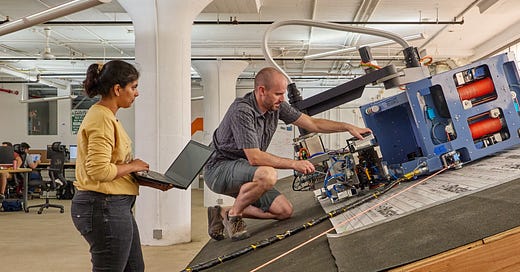
Discover more from Abe Murray | AlleyCorp / Deep Tech
Hi folks -
Closing out November with a newsletter talking about “the consensus view in robotics” and why we think it is wrong. Controversy drives clicks, right? But actually — we find this an important topic we keep bumping into, and figured we’d share it with our friends here.
By the “consensus view in robotics” - we mean what your average person on the street would respond with if you asked them what a robot is. Maybe a vacuum cleaner, but more likely a Star Wars Droid, a Boston Dynamics dog or humanoid, or a big industrial robot arm. These aren’t wrong answers. But they are also not the right answer.
How do we know this is the consensus view? Because ChatGPT says so. We were generating our weekly AlleyCorp Robotics comic, and realized that (a) LLMs reflect what people already "know", and (b) this illustrates how the consensus view on robots is humanoids and arms — which is not the right answer for most automation.
GPT - it just can't help but equate robots = humanoids = industrial arms!
The pictures are cute, but GPT just can't imagine a world of robots without humanoids. I pushed it harder - asking for humans using automation to build houses with higher productivity. GTP kept imagining arms.
The consensus view when folks think robots is humanoids, androids, lots of industrial robot arms. These can be expensive and overkill for most automation needs. A dishwasher in our house looks nothing like this - yet these are some of the most successful "robots" in history. Contrast GPT’s expectations with what innovative builders do - such as our portfolio company Renovate Robotics - making history with the first robotically installed roof:
Andy Stulc's innovation here is an automation solution for roofing - doubling the productivity of human labor in one of the most dangerous jobs humans still do. No humanoids, no industrial arms. Simple and effective.
So — robot founders → are you mimicking GPT and building the "consensus view" of what robotic solutions should be? 🤖 🦾 🦾
Or are you innovating a non-consensus solution to a problem you deeply understand by starting with the customer and their need? 🤖 📈 📈
Did we miss something in this analysis? Let us know - jump into the conversation on LinkedIn or Twitter / X.
Enjoy,
~Abe
PS - we aren’t saying robot arms and humanoids aren’t great solutions too - they have their place and are important. Huge fans of teams building with and around these areas as well!
PPS - thanks as well to Jay Kapoor of VSC Ventures and a great group of friends including AlleyCorp Robotics co-investors from ffVC, New System Ventures and Plum Alley who joined us last night in NYC for a dinner focusing on robotics, automation, climate, construction, data and AI!










True - form follows function. I expect this to be the design principle.
Even Androids won't always be human-like.
On that topic (and perhaps one to explore in this newsletter) , one mistake I see is the creation of personalities in Androids. Overly confident / effusive personalities are not someone we'd like to be around 24/7, like a gushing used car salesperson.
The optimal design is the 'shy' robot paradigm. The Android and you slowly get to know each other - likely avoiding each other until comfortable in the same space.
Starting from Curious/Civil then growing to Interested/engaged as interactions continue leading to comfortable then trusted, ascending to being close over time.